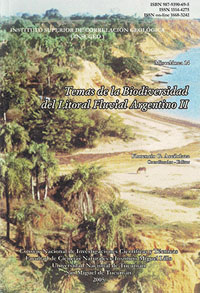Miscelánea 14
La vegetación del refugio educativo de la Ribera Norte, Provincia de Buenos Aires, Argentina. Invasión de especies exóticas.
Fabio A. Kalesnik | Marcela Cagnoni | P. Bertolini | Rubén D. Quintana | Nora Madanes | Ana Inés Malvárez
Descargar trabajo en formato PDFAbstract
THE VEGETATION OF THE RIVERA NORTE. PROVINCE OF BUENOS AIRES. EXOTIC SPECIES INVATION.The present study was carried out in the “Refugio Educativo de la Ribera Norte”, a small urban natural reserve (c 10 ha) located on the De la Plata River shore. The objective of this work was to describe the vegetation of the different cover-types and to analyze the invasion process of alien plant species on them. Six plant communities were identified using classification and ordination techniques. Four of them were characterized by a herbaceous species dominance: “juncal” (Schaenoplectus californicus), “verdolagal” (Ludwigia elegans), “camalotal” (Eichhornia azurea) and freshwater marsh (Zizaniopsis bonariensis, Iris psedacorus –an alien species from Europe- and Scirpus giganteus). The other two communities presented a forest phygsionomy and they had the highest species richness. The mixed forest was characterized by patches of Tessaria integrifolia, Phyllanthus sellowianus, Salix spp. and Ligustrum sinense (alien species from Asia). The canopy of the willow forest was dominated by Salix spp. and it presented an important understory with the alien plant L. sinence as the most abundant species. Isolated individuals of native forest species such as Blepharocalyx tweediei and Myrceugenia glaucescens were found as well. From a total number of 104 plant species found in the whole area, 15 were alien species (14.4%) and the most important were L. sinense, I. Psudacorus and Fraxinus spp. (from North America or Europe). These last species had a high frequency of occurrence at both community and landscape level. According to these results, it is necessary to incorporate an effective control program for the alien species populations and to manage the native forest recovery, which was almost eliminated in this region.






